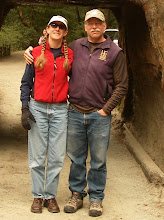Our first picture is from breakfast at our chambres d'hôte outside Gorron. The point is to show how delightfully large the coffee servings have been in France. In Greece and Italy we only got tiny little doll sized cups of coffee (expresso). Even in Italy if we asked for cafe americano it was about two doll cups size. But here in France, if you stipulate cafe, you get a mug or sometimes even a bowl full.

On Friday the ride to Pontorson, just 9k south of Mont Saint- Michel, was through pretty rolling farm land (bored with this yet? Well...that's just what it was). We have been seeing houses with beautiful gardens like this one.

As we got closer to Pontorson we began to smell the sea air, which stimulated our appetite for sea food. We had moules and frites for dinner.

They were great and we can understand why the people have been eating them with such gusto. Saturday morning we decided to take the local bus out to the mount. The highway was marked as a red road and would have a lot of traffic; we also couldn't envision where we would leave the bikes during our wandering. Well the bus was a great decision, the road was busy and there was a huge parking lot with no bicycle parking. Mont St. Michel was the 4th most important Christian pilgrimage site after Jerusalem, Rome, and Santiago de Compestela.

The initial sanctuary was built on the site in 708. In 966, Richard I grandfather of William the conquerer, established a Benedictine abbey on the site. They proceeded to build 4 chapels near the top of the mount which would later be the foundations of the Romanesque-Gothic church. These massive columns are under the church and hold up the altar area.


The original church was all Romanesque style (round arches in the front of the picture), but the original transept collapsed and was replaced in the Gothic style (pointed arches in the back of the picture). Being an abbey, there were areas for meditation and study.


The place is an architectural marvel, similar to the Pope's palace, with 4 levels of buildings on top of each other.

We had lunch in the fortified town below the abbey and noticed this terrier taking advantage of the rights of dogs in France.

Dogs are allowed in shops, bars, hotels and restaurants in France. They are very well behaved and seem to have earned their privileges. The tourist crowds were large and walking the streets below the abbey was difficult. We were glad to get on the bus and go back to quiet Pontorson and enjoy an excellent meal at the hotel. Belinda had a marvelous squid stuffed with risotto and we enjoyed a bottle of old vine Pinot Noir which had subtle fruit flavors and a dry finish. It was quite unlike our Monterey county Pinot, but very good. Sunday we head to St. Malo on our last full day in France.
















































